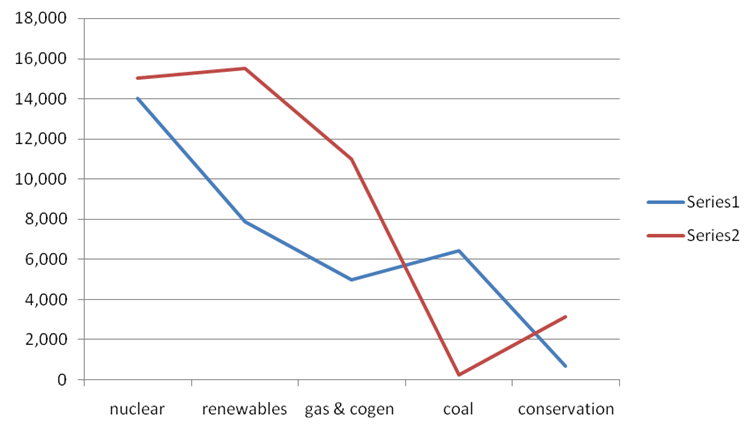Summary of the case study
The increase in dependency on fossil fuel and other non renewable energy sources is facing challenges because of environmental concerns and economic reasons. Fossil fuel releases green house gases and is prone to price fluctuations while hydroelectric power is dependent on environmental conditions.
Many countries are looking for alternative energy sources that are renewable cleaner and independent from price fluctuations. Solar energy, wind energy, tidal energy and geothermal energy are the main renewable sources of energy. This paper gives a summary of the renewable energy sources that two students contemplated and researched after finishing their graduate school.
Issues presented in the case study
The issues presented in this case were mainly concerned with the energy demands in Ontario. The need for the electricity supply mix to be replaced was the main issues that brought about the aspect of alternative energy sources. Large and Berkeley found out that renewable energy source was the way to go since other energy sources presented economic problems, environmental problems and scarcity.
They did an analysis of the different renewable energy sources and discovered that they could only venture into the renewable energy source that used the technology which they were best suited to capitalize on. A renewable energy source such as geothermal is pretty cheap but requires a lot of capital in order to establish its economic viability. Solar photovoltaic energy also requires a relatively large amount of capital although the standard offer price is pretty cheaper than some of the other sources.
Analysis of the case study
Large and Berkeley provides several different analysis of their research. They tabulate their data to compare between all the renewable energy that they researched on. There is also an analysis of the different energy sources that supply energy in Ontario. In an analysis of 2005 energy sources, it is evident that nuclear energy was the dominant energy source followed by renewable and coal in that order. Conservation was the least energy source that came behind gas and cogen.
Another analysis done for the future supply of energy in Ontario in the year 2025 indicates that renewables will take over from nuclear to become the dominant energy supplier. Nuclear takes the second position followed by gas and cogen, conservation and gasification in that order. The graph below shows the general trend of the energy sources from the year 2005 to the year 2025.

Series 1 represents the energy fractions in the year 2025, while series 2 shows the fractions in the year 2005.
In addition, Ontario’s standard offer program payment schedule tabulated in the file shows that solar photovoltaic energy is valued at $0.11 per Kilowatt hour. This price is way above the other energy sources that are offered the same value of $ 0.11 per kilowatt hour. All the prices are at base price.
The photovoltaic potential of Canadian cities is also compared to that of other cities. From the table, it can be deduced that Canadian cities have relatively high photovoltaic potential compared to many other world cities. The city of Regina is the sixth city with the most solar photovoltaic potential. It is followed by Calgary, Toronto, Vancouver, and St. John.
Another comparison was done on some quick facts for the renewable energies researched. The standard offer program price for solar voltaic energy potential is 42 cent per kW installed while that of other renewable energy sources like wind, hydropower and biogas is 11.08 cent per kW.
While there is an inflation index of 20 percent of the price increases by the consumer price index for all other renewable sources, the solar photovoltaic energy project has no inflation index. When the capital cost of the renewable energy sources are compared, solar photovoltaic energy leads with an estimated capital cost of $10, 000 to $14, 000, per kW installed. The table below summarizes the above analysis.
Table 1: Table of comparison of all the renewables discussed.
Adapted from Reeds, A. (2010). Renewable Energy Co. Richard Ivy School of Business Foundation
Results
From the graph in figure 1, even though the energy output and usage increases, the general trend is that renewable energy is slowly but gradually taking over the energy scene. From the table above, it can be deduced that solar energy is the most expensive in terms of standard offer time. Solar photovoltaic energy also requires the most capital cost. It is also quite expensive in terms of average lead time. However, solar energy needs no environmental permit and has the least number of permits needed.
Recommendations
It is beyond doubt that renewable energy is the most appropriate alternative energy source that can be utilize for sustainable economic growth and environment management.
Since fossil fuel prices are always fluctuating, they affect economies and thus contribute to inflation. Fossil fuels also contribute to greenhouse gases because they produce carbon dioxide and sulfur dioxide. Carbon dioxide depletes the ozone layer which is essential for blocking ultraviolet rays that may otherwise cause skin cancer. Sulfur dioxide is known to cause acid rain that corrodes man made structures.
Renewable energy sources are clean, cheaper, and stable for economic development. In my own opinion, since wind, solar, hydroelectricity and biogas, all depend on environmental conditions, I would recommend geothermal energy to be sourced in tectonically active areas. This renewable energy source does not depend on climatic conditions. It is available throughout the years and the earth’s interior is not going to cool soon.
Reference List
Reeds, A. (2010). Renewable Energy Co. Richard Ivy School of Business Foundation.